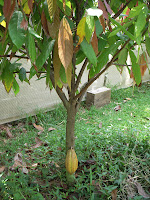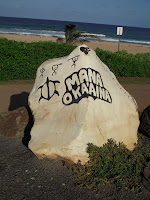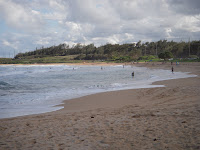 Even though it is a “wet” island, the sun usually shines some part of each day, making it a necessity to sample beaches every day. By this time, Louise’s car was off the road for brake repairs and I was cruising in the “Bad Boy” truck!
Even though it is a “wet” island, the sun usually shines some part of each day, making it a necessity to sample beaches every day. By this time, Louise’s car was off the road for brake repairs and I was cruising in the “Bad Boy” truck! Louise and I were sharing transportation. After dropping her off at work in Lihue, I thought I would take advantage of a cultural experience and see the Hawaiian Quilt exhibit at the Kauai Museum. I couldn’t resist stopping in to say hello Keith, at the counter at the Lihue PO.
Louise and I were sharing transportation. After dropping her off at work in Lihue, I thought I would take advantage of a cultural experience and see the Hawaiian Quilt exhibit at the Kauai Museum. I couldn’t resist stopping in to say hello Keith, at the counter at the Lihue PO. Unable to locate the “public access” at the Marriott Resort beach, I headed to Lydgate Park in Wailua for a swim. The Lydgate Beach is a keiki (children) friendly beach; there is a lovely swimming lagoon set off from the ocean by lava rock walls. It was a lovely day and my favorite little Brazilian Cardinals were hanging out with me. Aren’t they cute?
Unable to locate the “public access” at the Marriott Resort beach, I headed to Lydgate Park in Wailua for a swim. The Lydgate Beach is a keiki (children) friendly beach; there is a lovely swimming lagoon set off from the ocean by lava rock walls. It was a lovely day and my favorite little Brazilian Cardinals were hanging out with me. Aren’t they cute?

I thought a chocolate tour sounded interesting. The Steelgrass Farm was so – called after a nickname for bamboo, a member of the grass family with mechanical strength that rivals metal. This 8-acre property was purchased in the 1990’s. Although the family has deep roots to the island, the farm was acquired rather than passed down through the generations. Clearing the land of invasive scrub was the first step. Although they found no evidence of earlier plantation-era sugar cane or pineapple, there was feral taro and artifacts unearthed in the stream lowlands that suggest that taro and rice may have been grown on the property in the first half of the century.
The farm, by and large, was replanted with seeds, cuttings, or seedlings. The plantings were guided by two principles. First, for practical reasons, the varieties needed to provide food, so the farm would be an edible landscape. Second, for spiritual reasons, the plantings would nourish a tranquil, meditative landscape, that in turn, would nourish the body.
The fruit tree selections were guided by their experience of what grows well in the eastern part of the island. Citrus, of course, including limes and Meyer lemons, juice oranges and two specialty varieties, a Moro Blood orange and a Key lime. Avocados, too, but as with citrus, they wanted to be careful not to over-plant and limited the avocados to three avocado varieties. Mango trees have the intriguing custom of fruiting irregularly, with some on-years and some off-years, a custom, which of course interacts with local growing conditions. There are also multiple banana patches.
 Soursop, sometimes called custard apple, is astonishing fruit. It is a bizarre dark-green lobed and curling shape studded with spikes, has a truly sublime taste. (This is a pic from Linda’s yard on the west side) Soursop’s creamy-white flesh houses big shiny, slippery black seeds, which are great fun to spit out. Its taste is sweet lemon-lime vanilla custard, mixed with coconut, pineapple and a dash of strawberry.
Soursop, sometimes called custard apple, is astonishing fruit. It is a bizarre dark-green lobed and curling shape studded with spikes, has a truly sublime taste. (This is a pic from Linda’s yard on the west side) Soursop’s creamy-white flesh houses big shiny, slippery black seeds, which are great fun to spit out. Its taste is sweet lemon-lime vanilla custard, mixed with coconut, pineapple and a dash of strawberry.Guava and passion fruit, two of the local favorite fruits, are also among Hawaii’s most aggressive alien invaders. Guava (with slightly-less-than-tennis-ball size yellow fruit) and strawberry guava (big-marble-size red fruit) multiply exponentially in tropical climates by virtue of the fact that their brightly colored fruits are highly visible, and therefore highly appealing, to local birds. Each contains hundreds of small seeds, which pass unaffected through the birds’ digestive tracts, after which their avian hosts conveniently distribute them everywhere in their droppings, each seed lovingly plopped on the ground in a fertilizer-rich package that virtually guarantees germination and the birth of yet another guava tree. Dozens of bamboo species were selected for their usefulness in building construction, crafts and furniture, and making musical instruments
Not long after the end of the Second World War, Kauai began losing its two monocrops: sugar and pineapple. Within the space of a generation, the colonial plantation model of intensive deliberate cultivation transformed the lowlands to near abandonment. The “green space” on this island is testament to the failure of plantation-style monocropping.
The mission of the Steelgrass Farm is to restore the agriculture to the island within the confines of current social and economic circumstances. They believe that part-time farming is the key. It becomes practical and economically viable for many smallholders to grow diversified crops. In fulfilling this vision, Steelgrass Farm has emerged as a teaching farm to educate their Kauai neighbors in the ”how to” of planting, tending, harvesting, and marketing the crops. Their specialty is limited to three crops: timber bamboo, vanilla, and the obroma cacao (the chocolate tree).


The chocolate tour is much more of a botanical tour. The chocolate trees are the highlight, however, the black bamboo and the Red Sealing Wax Palm were my favorites.


Hawaii is the only state where the chocolate tree grows. Cacao is recognized as a powerful health food and after learning about its antioxidant and other health benefit, a blind tasting of 10 varieties of dark chocolate before noon seemed perfectly okay!


The chocolate tour is designed to stimulate the senses. This includes a ten-course dark chocolate tasting, We sampled some of the world's rarest and most costly single-estate dark chocolate bars, from makers such as Scharffenberger, Guittard and Dagoba (USA), Valrhona (France), Felchlin (Switzerland), and Amedei (Italy).
As we tasted chocolate, we learned of the historical perspective: tracing the cacao discovery by the Meso-American tribes, to its “divine plant” status in the Mayan and Aztec cultures. In the 1600’s, chocolate was introduced in Europe, and lastly we met Milton Hershey, a local (Pennsylvania) inventor, who introduced the nickel Hershey bar in1905 and the Hershey’s kiss in 1907.
The farm itself is diversified, highlighting local musicians and offering B & B accommodations. The family’s vision for creating sustainable diversified agriculture on Kauai is a strong thread that is woven throughout the tour.


Shopping at the Lihue Farmers’ Market is an event – go early for the best selection! I tasted my first cold coconut.


Keailia Beach, in the ‘hood, was sun drenched this afternoon. The water was that perfect aquamarine blue! The words on the rock loosely translate - The Power of the Land.
Sleeping Giant looms over the coastal villages of Wailua and Waipouli. If you look inland while driving on the Kuhio Highway, you can see what appears to be the legendary giant Puni. As the story goes, he fell asleep after a great feast, his head toward Wailua and his feet Kapaa. Sleeping Giant rests on the 1241 ft NouNou Ridge.


Louise and I were up for another hiking challenge. The trail meanders through the forests of Norfolk pines, strawberry guava and then, as we climbing, through the hala trees. The climb to the top was well worth it.
 The view of the valley is beautiful. I loved this bench! We sang a rendition of Aretha’s R-E-S-P-E-C-T.
The view of the valley is beautiful. I loved this bench! We sang a rendition of Aretha’s R-E-S-P-E-C-T.
Hiking is usually followed with a swim. This time we ventured to Anahola Beach. Tucked behind Kala Point, this narrow park has a shallow offshore reef that protects the sandy shoreline from the area’s high surf.

And the adventure continues…
No comments:
Post a Comment